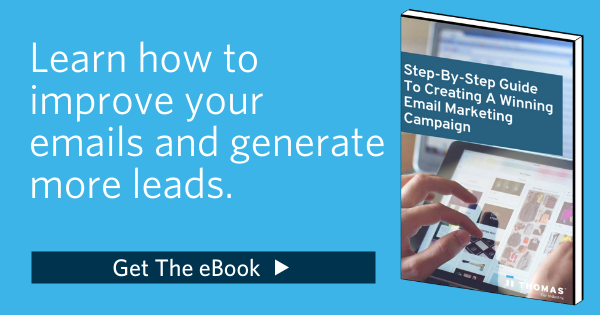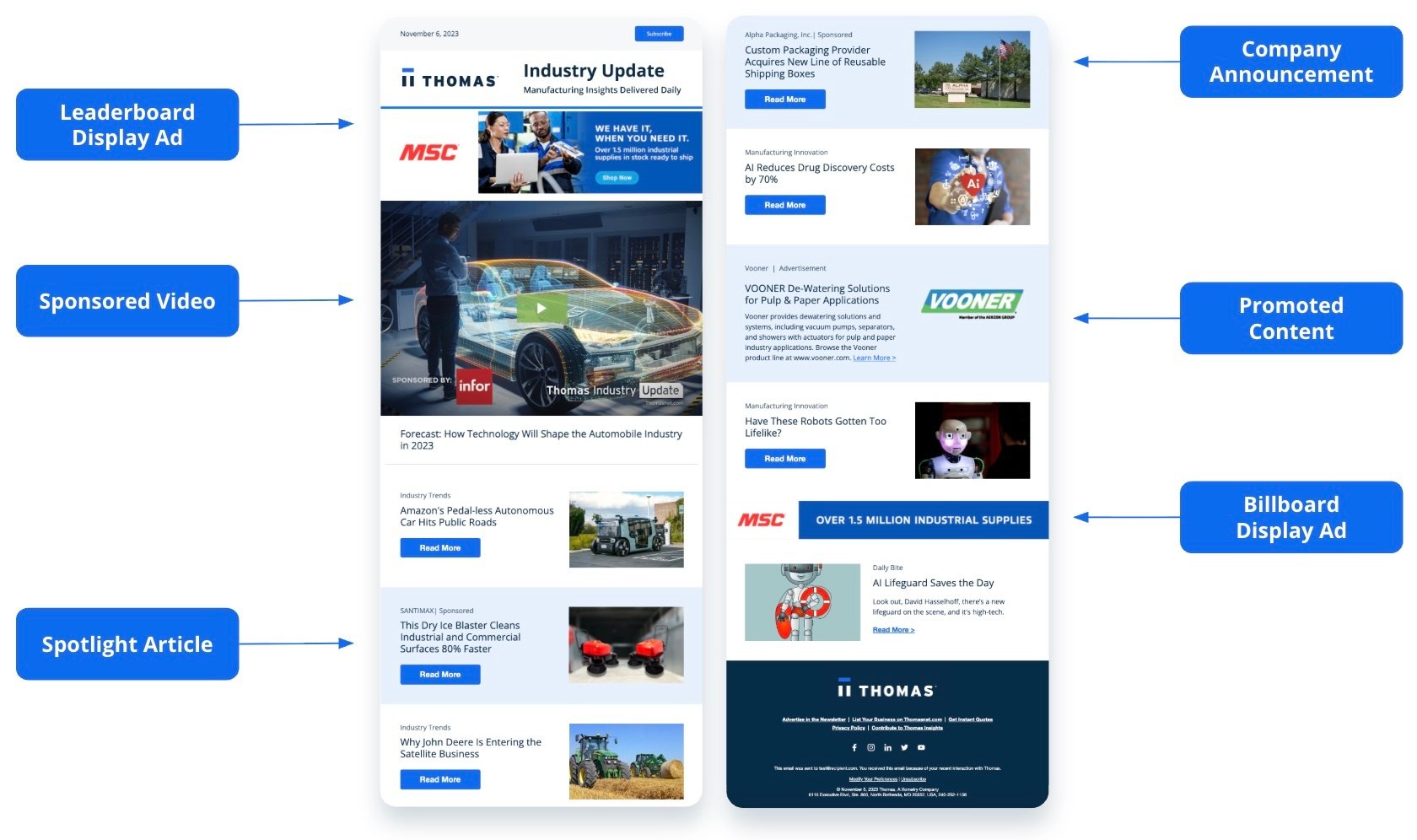How To Get People To Read Your Sales Emails (And What Not To Do)
Team Thomas September 22, 2020
It's no secret that email marketing is one of the best ways to drive leads to your sales team. However, most manufacturers and industrial companies don't realize that it's also one of the best ways to close those leads and convert them into customers.
So while a lot of time and energy is going into optimizing marketing emails, sales emails are often relegated to an afterthought. In fact, the task of writing, designing, and deploying sales emails often falls on individual sales reps, who have little guidance, direction, or support. That's a recipe for disaster, and it shouldn't be the case.
If you want to optimize your sales emails for maximum results, be sure to follow these suggestions.

1. Change The Subject (Line)
The subject line is the first thing your readers will see, so it should be clear, concise, and eye-catching.
Over the last few days — the last few hours even — you’ve likely banished plenty of unopened emails to the trash. And many of these trash-bound emails probably had off-putting subject lines, right? Lousy subject lines that bore people, or terrify them into thinking they’re about to download a virus, are not doing your company any favors. So devise a subject line that compels without sounding sketchy or pushy.
If you make it too innocuous or vague, you risk being looked over. Try personalizing subject lines with the recipients’ names. Or work something into the subject line you've already discussed with the recipient or identify you as the sender. You can also refer to a specific goal you know they want to reach.
And keep it short. Like, under-30-characters short. If your audience is highly mobile (which most are nowadays), odds are their devices won’t show more than a handful of words in the subject line anyway. And remember to leave out words like “free,” “sale,” and “discount,” or you’ll smell like spam. Test out a couple of different subject lines and see what earns you the most attention.
Related Resource: 9 Tips For Writing Effective B2B Email Subject Lines (With Examples)
2. Make Your Emails About Them, Not About You
Don’t open with formal introductions or explanations on why you’re pestering them. Nobody reads beyond these generic openings. You won’t get a second date by gushing about yourself, and you won’t get a sale that way, either. Instead, focus on the consumers’ needs and goals.
Although it’s important to let your readers know who you are and what you’re about, emails should clearly show what you can offer and how you can help their pain points. Provide readers with directly useful content, and they’ll be much more likely to engage with your brand.
Do your homework on your target and find a way to prove that you did so. Mention a recent news piece about their company (assuming it wasn’t scandalous). Say something intelligent about their new blog post. If they converted on another offer or downloaded an eBook in the past, offer further insight into whatever they showed interest in. Don't stalk like an unhinged ex, but do make them feel seen.
3. Keep Your Email Message Clear
Respect your prospect’s time. Keep things short and sweet, direct and straightforward; trim your message to as few words as possible. Any word in your sales email over the 150 count should go to the chopping block; restructure and reword as necessary to keep it at or under this threshold.
And if you have more to say than can reasonably be squeezed into 150 words, then use the email as a lead-in to a blog post or some other type of valuable offering. This gives users the choice to click through if they want to explore further, and gives you more permanent, shareable marketing content.
Read More: 12 Ways To Improve Your Manufacturing Blog
4. Tell Users What You Want
The people you’re emailing already know you want something from them. Don’t leave them guessing as to what it is. Do you want them to make an appointment? Visit your website? Go over an RFP? Figure out what you want, and ask for it.
And make it easy for them to give you what you want by including instructions and shortcuts. Provide links that take them directly where you want them to go. Prominently display your phone number or email address. Use tools like Calendly that allow recipients to schedule their own meetings. In short, make it as easy for them as possible.
5. Sound Professional & Reliable
If you were a potential client opening up your email, would you trust your company? Does the email sound professional, polished, and engaging? If your sales team is still writing their own emails, you may want to consider having a pro clean them up. Also, sending industrial emails from generic email addresses like info@yourcompanyname.com reduces your credibility and is an email marketing "don't."
6. Run Spell Check
If your email contains typos, broken links, bad grammar, and other clues that you had too little caffeine in your system when you wrote the thing, nobody will trust you. And if they don’t trust you, they won’t give you money.
Serious business calls for serious credibility, which you seriously won’t get if your message is chock-full of errors. So take the time to read and reread, and only publish once it’s perfect.
7. Clean Your Email List
When was the last time you updated your contact list? Make sure your contacts are being tracked — what did they click on, what page did they visit, etc. If an email address bounced, update it in your system. Email marketing should help grow your contact list and help you learn about them so you can create more useful content to help them do their jobs — while keeping your business top of mind. Your contact list should not be stagnant.
Turn your lists into leads. And to bring in new leads, make sure you’re implementing smart SEO and PPC strategies. Working hand-in-hand, these tactics are critical for driving new traffic to your site.
Have You Exhausted Your List Of Contacts?
Utilize the Thomas Audience & reach 300K+ decision-makers with Newsletter Advertising in Thomas Industry Update.
8. Play With The Timing Of Your Email Sends
When exactly should you send these glorious emails? Frankly, we don’t know. Optimal timing depends on many things — namely, on whom you’re contacting. There are plenty of studies devoted to analyzing sales and marketing email scheduling, and many different opinions floating around, but it really all depends on your specific contact list. Experiment with varying schedules of sending to see what works best for you.
How Do Your Email Open Rates Compare To Others In The Industry: 2020 Industrial Marketing Benchmarks For Manufacturers & Distributors
Report On Your Email Results Regularly
While a measure of intuition and common sense can help guide you throughout your sales email campaigns, data should inform you about what is and isn't working. For instance, HubSpot CRM is an excellent tool for gaining valuable insight into your emails' efficacy, allowing you to track email opens, schedule sending easily, and create sophisticated email templates. And it's free, so you have no excuse not to learn from your results.
What's Next? Read 9 Email Marketing Types You Should Be Sending (And Why)
Curious to learn more about the best methods for effective sales emails, or just need some help getting started? The industrial marketing team at Thomas can help. Ask us about a free digital health check to see exactly how you can improve your efforts online to be more engaging to your buyers.
Did you find this useful?











